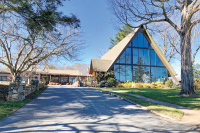Working to bring back the American chestnut
By Julie Ball • Correspondent
As a boy, Gene Gibson remembers his parents heading to some of Western North Carolina’s high mountain ridges in search of chestnuts.
By that time — the early 1930s — most of the trees at the lower elevations were dead, killed by a devastating chestnut blight that all but wiped out the species.
“Most of the chestnut trees down here had already died, but there were still some in the higher ridges that were still producing,” said Gibson, who lives in Jackson County.
For southern Appalachian families, the American chestnut was an important part of life. Not only did it produce food for livestock and timber for homes, but the chestnuts from these massive trees could be used to barter or to sell.
Now a modern-day effort to bring back the tree is taking an important step forward. The U.S. Forest Service, American Chestnut Foundation and officials from the University of Tennessee recently announced the planting of 500 blight-resistant trees on U.S. Forest Service land in North Carolina, Tennessee and Virginia.
Related Items
The planting took place last winter, and the trees have thrived over the past year, according to forestry officials.
“Today really is a historic event,” said Bryan Burhans, president of The American Chestnut Foundation, which has been working for more than 25 years to develop a blight-resistant tree.
The foundation has been breeding the blight-resistant Chinese chestnut with the American chestnut, resulting in a mix that is genetically 94 percent American chestnut and 6 percent Chinese chestnut. The cross will hopefully provide just enough DNA from the Chinese chestnut to stave off the blight, yet still boasts the signature characteristics of the American chestnut, such as the prized nuts and high quality wood.
Roger Williams, director of forest management for the U.S. Forest Service Southern Region, called the test planting another step toward re-introducing this “keystone species” to its native range decades after it was wiped out.
Forest experiment
The chestnut seedlings planted last year have grown an average of 10 inches already.
Stacy Clark, research forester for the U.S. Forest Service Southern Research Station, described them as “healthy” and “free from blight,” but it will take several more years to determine if they are blight resistant.
Clark said the blight normally doesn’t show up until the trees are five to 10 years old.
“We are hopeful the test plantings conducted last winter will be successful,” said Barbara Crane, regional geneticist for the U.S. Forest Service Southern Region.
The 500 blight-resistant trees were among a total of 1,200 trees planted at three locations on national forest land.
The other 700 trees included pure American chestnut trees, pure Chinese chestnut trees and various generations of trees that are a mixture of the two species. The seedlings grew for a year in a nursery before they were planted as part of this effort.
“These first test plantings are true scientific experiments,” Clark said.
Officials will monitor the growth and determine whether they can survive and what kind of management might be needed.
“Also, it’s important to determine how these trees will grow in a real-world setting,” Clark said.
The Forest Service and University of Tennessee planted the trees on Forest Service land under a memorandum of understanding with The American Chestnut Foundation. The agencies are not saying exactly where the trees are planted to protect them from possible theft.
“The trees we planted are approximately 4- to 6-feet tall. They came from nuts that were collected over two years ago,” Clark said.
Plans call for another 500 blight-resistant trees to be planted in 2010 on national forest land. The American Chestnut Foundation is also working to develop a plan for future restoration of the trees. The American Chestnut Foundation recevied a $1 million contribution last year from the Stanback family, known as champions of conservation in Western North Carolina for their large contributions to preserve tracts of land.
Loss of the chestnut
The loss of the American chestnut tree was a “disaster,” according to Gibson, who lives in Jackson County.
Chestnuts made up 25 percent of the hardwood forests in the eastern U.S. The massive trees grew alongside oaks, but they produced more mast and also produced food more consistently. Burhans said a mature oak would produce 1,000 acorns on average — but a mature American chestnut tree produced 6,000 chestnuts on average.
The chestnuts were an important source of food in the forest, but they also provided a crop that could be sold by people living in the southern Appalachian region.
Gene Gibson’s son, Bill Gibson, who serves as executive director of the Southwestern Commission, said his grandmother was born in Haywood County and later lived in Jackson County. She told stories of heading to high mountain coves during the fall to collect chestnuts.
The family would bring along buckets, washtubs, and any other containers they could find. They’d also bring along livestock to fatten them up on the chestnuts.
“They (the family) would go back there, and they’d stay a long time, maybe a week or more,” Bill Gibson said.
The family would roast the chestnuts on site, then haul them home to use during the winter.
Timber from the American chestnut was also used heavily in the mountains. And Western North Carolina is full of stories about the size of the trees. In some cases, it took several people holding hands to reach around the massive trunks.
The trees contributed to the overall health of the ecosystem and were a valuable source of food for wildlife, according to Williams. But in the first half of the 20th century, the trees began dying, hit by a fungus that would become known as the chestnut blight. By the early 1950s, the American chestnut had virtually disappeared, even at the high elevations.
Sprouts from the old root systems can still be found in mountain forests, and one goal of The American Chestnut Foundation is to collect pollen from those native trees for use in the breeding process.
The foundation developed the blight-resistant trees using backcross-breeding over a number of years.









